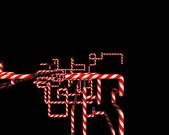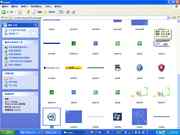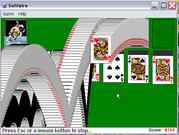Friday, February 15, 2013
Wednesday, February 13, 2013
What is aphasia?
Aphasia is a disorder that results from damage to portions of the brain that are responsible for language. For most people, these are areas on the left side (hemisphere) of the brain. Aphasia usually occurs suddenly, often as the result of a stroke or head injury, but it may also develop slowly, as in the case of a brain tumor, an infection, or dementia. The disorder impairs the expression and understanding of language as well as reading and writing. Aphasia may co-occur with speech disorders such as dysarthria or apraxia of speech, which also result from brain damage.
Who has aphasia?
Anyone can acquire aphasia, including children, but most people who have aphasia are middle-aged or older. Men and women are equally affected. According to the National Aphasia Association, approximately 80,000 individuals acquire aphasia each year from strokes. About one million people in the United States currently have aphasia.
What causes aphasia?
Aphasia is caused by damage to one or more of the language areas of the brain. Many times, the cause of the brain injury is a stroke. A stroke occurs when blood is unable to reach a part of the brain. Brain cells die when they do not receive their normal supply of blood, which carries oxygen and important nutrients. Other causes of brain injury are severe blows to the head, brain tumors, brain infections, and other conditions that affect the brain.

What are the types of aphasia?
There are two broad categories of aphasia: fluent and non-fluent.
Fluent aphasia
Damage to the temporal lobe (the side portion) of the brain may result in a fluent aphasia called Wernicke's aphasia (see figure). In most people, the damage occurs in the left temporal lobe, although it can result from damage to the right lobe as well. People with Wernicke's aphasia may speak in long sentences that have no meaning, add unnecessary words, and even create made-up words. For example, someone with Wernicke's aphasia may say, "You know that smoodle pinkered and that I want to get him round and take care of him like you want before." As a result, it is often difficult to follow what the person is trying to say. People with Wernicke's aphasia usually have great difficulty understanding speech, and they are often unaware of their mistakes. These individuals usually have no body weakness because their brain injury is not near the parts of the brain that control movement.
Non-fluent aphasia
A type of non-fluent aphasia is Broca's aphasia. People with Broca's aphasia have damage to the frontal lobe of the brain. They frequently speak in short phrases that make sense but are produced with great effort. They often omit small words such as "is," "and," and "the." For example, a person with Broca's aphasia may say, "Walk dog," meaning, "I will take the dog for a walk," or "book book two table," for "There are two books on the table." People with Broca's aphasia typically understand the speech of others fairly well. Because of this, they are often aware of their difficulties and can become easily frustrated. People with Broca's aphasia often have right-sided weakness or paralysis of the arm and leg because the frontal lobe is also important for motor movements.
Another type of non-fluent aphasia, global aphasia, results from damage to extensive portions of the language areas of the brain. Individuals with global aphasia have severe communication difficulties and may be extremely limited in their ability to speak or comprehend language.
There are other types of aphasia, each of which results from damage to different language areas in the brain. Some people may have difficulty repeating words and sentences even though they can speak and they understand the meaning of the word or sentence. Others may have difficulty naming objects even though they know what the object is and what it may be used for.
How is aphasia treated?
For most cases, however, language recovery is not as quick or as complete. While many people with aphasia experience partial spontaneous recovery, in which some language abilities return a few days to a month after the brain injury, some amount of aphasia typically remains. In these instances, speech-language therapy is often helpful. Recovery usually continues over a two-year period. Many health professionals believe that the most effective treatment begins early in the recovery process. Some of the factors that influence the amount of improvement include the cause of the brain damage, the area of the brain that was damaged, the extent of the brain injury, and the age and health of the individual. Additional factors include motivation, handedness, and educational level.
Aphasia therapy aims to improve a person's ability to communicate by helping him or her to use remaining language abilities, restore language abilities as much as possible, compensate for language problems, and learn other methods of communicating. Individual therapy focuses on the specific needs of the person, while group therapy offers the opportunity to use new communication skills in a small-group setting. Stroke clubs, regional support groups formed by people who have had a stroke, are available in most major cities. These clubs also offer the opportunity for people with aphasia to try new communication skills. In addition, stroke clubs can help a person and his or her family adjust to the life changes that accompany stroke and aphasia. Family involvement is often a crucial component of aphasia treatment so that family members can learn the best way to communicate with their loved one.
Family members are encouraged to:
- Simplify language by using short, uncomplicated sentences.
- Repeat the content words or write down key words to clarify meaning as needed.
- Maintain a natural conversational manner appropriate for an adult.
- Minimize distractions, such as a loud radio or TV, whenever possible.
- Include the person with aphasia in conversations.
- Ask for and value the opinion of the person with aphasia, especially regarding family matters.
- Encourage any type of communication, whether it is speech, gesture, pointing, or drawing.
- Avoid correcting the person's speech.
- Allow the person plenty of time to talk.
- Help the person become involved outside the home. Seek out support groups such as stroke clubs.
"Tourette" redirects here. For other uses, see Tourette (disambiguation).
| Tourette syndrome | |
|---|---|
| Classification and external resources | |
 Georges Gilles de la Tourette (1857–1904), namesake of Tourette syndrome | |
| ICD-10 | F95.2 |
| ICD-9 | 307.23 |
| OMIM | 137580 |
| MedlinePlus | 000733 |
| eMedicine | med/3107 neuro/664 |
| MeSH | D005879 |
Tourette's was once considered a rare and bizarre syndrome, most often associated with the exclamation of obscene words or socially inappropriate and derogatory remarks (coprolalia), but this symptom is present in only a small minority of people with Tourette's.[1] Tourette's is no longer considered a rare condition, but it is not always correctly identified because most cases are mild and the severity of tics decreases for most children as they pass through adolescence. Between 0.4% and 3.8% of children ages 5 to 18 may have Tourette's;[2] the prevalence of transient and chronic tics in school-age children is higher, with the more common tics of eye blinking, coughing, throat clearing, sniffing, and facial movements. Extreme Tourette's in adulthood is a rarity, and Tourette's does not adversely affect intelligence or life expectancy.
Genetic and environmental factors play a role in the etiology of Tourette's, but the exact causes are unknown. In most cases, medication is unnecessary. There is no effective treatment for every case of tics, but certain medications and therapies can help when their use is warranted. Education is an important part of any treatment plan, and explanation and reassurance alone are often sufficient treatment.[1][3] Comorbid conditions (co-occurring diagnoses other than Tourette's) such as attention-deficit hyperactivity disorder (ADHD) and obsessive–compulsive disorder (OCD) are present in many patients seen in tertiary specialty clinics. These other conditions often cause more functional impairment to the individual than the tics that are the hallmark of Tourette's, hence it is important to correctly identify comorbid conditions and treat them.[4]
The eponym was bestowed by Jean-Martin Charcot (1825–1893) on behalf of his resident, Georges Albert Édouard Brutus Gilles de la Tourette (1859–1904), a French physician and neurologist, who published an account of nine patients with Tourette's in 1885.
Classification
Tics are sudden, repetitive, nonrhythmic movements (motor tics) and utterances (phonic tics) that involve discrete muscle groups.[5] Motor tics are movement-based tics, while phonic tics are involuntary sounds produced by moving air through the nose, mouth, or throat.
Tourette's is one of several tic disorders, which are classified by the Diagnostic and Statistical Manual of Mental Disorders (DSM) as "disorders usually first diagnosed in infancy, childhood, or adolescence" according to type (motor or phonic tics) and duration (transient or chronic). Transient tic disorder consists of multiple motor tics, phonic tics or both, with a duration between four weeks and twelve months. Chronic tic disorder is either single or multiple, motor or phonic tics (but not both), which are present for more than a year.[5] Tourette's (DSM-IV 307.23) is diagnosed when multiple motor tics, and at least one phonic tic, are present for more than a year.[6] The fifth version of the DSM (DSM-5), due out in May 2013, is likely to reclassify Tourette's as a neurodevelopmental disorder, and to include additional diagnoses to account for tic disorders due to substance abuse or other general medical conditions.[7]
Tic disorders are defined only slightly differently by the World Health Organization International Statistical Classification of Diseases and Related Health Problems, ICD-10; code F95.2 is for combined vocal and multiple motor tic disorder [de la Tourette].[8]
Although Tourette's is the more severe expression of the spectrum of tic disorders,[9] most cases are mild.[2] The severity of symptoms varies widely among people with Tourette's, and mild cases may be undetected.[5]
Characteristics
Tics are movements or sounds "that occur intermittently and unpredictably out of a background of normal motor activity",[10] having the appearance of "normal behaviors gone wrong".[11] The tics associated with Tourette's change in number, frequency, severity and anatomical location. Waxing and waning—the ongoing increase and decrease in severity and frequency of tics—occurs differently in each individual. Tics also occur in "bouts of bouts", which vary for each person.[5]Coprolalia (the spontaneous utterance of socially objectionable or taboo words or phrases) is the most publicized symptom of Tourette's, but it is not required for a diagnosis of Tourette's and only about 10% of Tourette's patients exhibit it.[1] Echolalia (repeating the words of others) and palilalia (repeating one's own words) occur in a minority of cases,[5] while the most common initial motor and vocal tics are, respectively, eye blinking and throat clearing.[12]
In contrast to the abnormal movements of other movement disorders (for example, choreas, dystonias, myoclonus, and dyskinesias), the tics of Tourette's are temporarily suppressible, nonrhythmic, and often preceded by an unwanted premonitory urge.[13] Immediately preceding tic onset, most individuals with Tourette's are aware of an urge,[14][15] similar to the need to sneeze or scratch an itch. Individuals describe the need to tic as a buildup of tension, pressure, or energy[15][16] which they consciously choose to release, as if they "had to do it"[17] to relieve the sensation[15] or until it feels "just right".[17][18] Examples of the premonitory urge are the feeling of having something in one's throat, or a localized discomfort in the shoulders, leading to the need to clear one's throat or shrug the shoulders. The actual tic may be felt as relieving this tension or sensation, similar to scratching an itch. Another example is blinking to relieve an uncomfortable sensation in the eye. These urges and sensations, preceding the expression of the movement or vocalization as a tic, are referred to as "premonitory sensory phenomena" or premonitory urges. Because of the urges that precede them, tics are described as semi-voluntary or "unvoluntary",[10] rather than specifically involuntary; they may be experienced as a voluntary, suppressible response to the unwanted premonitory urge.[1] Published descriptions of the tics of Tourette's identify sensory phenomena as the core symptom of the syndrome, even though they are not included in the diagnostic criteria.[16][19][20]
Causes
Main article: Causes and origins of Tourette syndrome
The exact cause of Tourette's is unknown, but it is well established that both genetic and environmental factors are involved.[28] Genetic epidemiology studies have shown that the overwhelming majority of cases of Tourette's are inherited, although the exact mode of inheritance is not yet known and no gene has been identified.[4][29][30] In other cases, tics are associated with disorders other than Tourette's, a phenomenon known as tourettism.[31]A person with Tourette's has about a 50% chance of passing the gene(s) to one of his or her children, but Tourette's is a condition of variable expression and incomplete penetrance.[32] Thus, not everyone who inherits the genetic vulnerability will show symptoms; even close family members may show different severities of symptoms, or no symptoms at all. The gene(s) may express as Tourette's, as a milder tic disorder (transient or chronic tics), or as obsessive–compulsive symptoms without tics. Only a minority of the children who inherit the gene(s) have symptoms severe enough to require medical attention.[33] Gender appears to have a role in the expression of the genetic vulnerability: males are more likely than females to express tics.[21]
Non-genetic, environmental, post-infectious, or psychosocial factors—while not causing Tourette's—can influence its severity.[22] Autoimmune processes may affect tic onset and exacerbation in some cases. In 1998, a team at the US National Institute of Mental Health proposed a hypothesis based on observation of 50 children that both obsessive–compulsive disorder (OCD) and tic disorders may arise in a subset of children as a result of a poststreptococcal autoimmune process.[2] Children who meet five diagnostic criteria are classified, according to the hypothesis, as having Pediatric Autoimmune Neuropsychiatric Disorders Associated with Streptococcal infections (PANDAS).[34] This contentious hypothesis is the focus of clinical and laboratory research, but remains unproven.[1][2][35]
Some forms of OCD may be genetically linked to Tourette's.[18][36] A subset of OCD is thought to be etiologically related to Tourette's and may be a different expression of the same factors that are important for the expression of tics.[37] The genetic relationship of ADHD to Tourette syndrome, however, has not been fully established.[27]
Pathophysiology
The exact mechanism affecting the inherited vulnerability to Tourette's has not been established, and the precise etiology is unknown. Tics are believed to result from dysfunction in cortical and subcortical regions, the thalamus, basal ganglia and frontal cortex.[28] Neuroanatomic models implicate failures in circuits connecting the brain's cortex and subcortex,[22] and imaging techniques implicate the basal ganglia and frontal cortex.[29]Diagnosis
According to the revised fourth edition of the Diagnostic and Statistical Manual of Mental Disorders (DSM-IV-TR), Tourette’s may be diagnosed when a person exhibits both multiple motor and one or more vocal tics (although these do not need to be concurrent) over the period of a year, with no more than three consecutive tic-free months. The previous DSM-IV included a requirement for "marked distress or significant impairment in social, occupational or other important areas of functioning", but this requirement was removed in the most recent update of the manual, in recognition that clinicians see patients who meet all the other criteria for Tourette's, but do not have distress or impairment.[38] The onset must have occurred before the age of 18, and cannot be attributed to the "direct physiological effects of a substance or a general medical condition".[6] Hence, other medical conditions that include tics or tic-like movements—such as autism or other causes of tourettism—must be ruled out before conferring a Tourette's diagnosis.There are no specific medical or screening tests that can be used in diagnosing Tourette's;[18] it is frequently misdiagnosed or underdiagnosed, partly because of the wide expression of severity, ranging from mild (the majority of cases) or moderate, to severe (the rare, but more widely recognized and publicized cases).[23] Coughing, eye blinking and tics that mimic asthma are commonly misdiagnosed.[1]
The diagnosis is made based on observation of the individual's symptoms and family history,[1] and after ruling out secondary causes of tic disorders.[33] In patients with a typical onset and a family history of tics or obsessive–compulsive disorder, a basic physical and neurological examination may be sufficient.[9]
There is no requirement that other comorbid conditions (such as ADHD or OCD) be present,[1] but if a physician believes that there may be another condition present that could explain tics, tests may be ordered as necessary to rule out that condition. An example of this is when diagnostic confusion between tics and seizure activity exists, which would call for an EEG, or if there are symptoms that indicate an MRI to rule out brain abnormalities.[39] TSH levels can be measured to rule out hypothyroidism, which can be a cause of tics. Brain imaging studies are not usually warranted.[39] In teenagers and adults presenting with a sudden onset of tics and other behavioral symptoms, a urine drug screen for cocaine and stimulants might be necessary. If a family history of liver disease is present, serum copper and ceruloplasmin levels can rule out Wilson's disease.[9] Most cases are diagnosed by merely observing a history of tics.[22]
Secondary causes of tics (not related to inherited Tourette syndrome) are commonly referred to as tourettism.[31] Dystonias, choreas, other genetic conditions, and secondary causes of tics should be ruled out in the differential diagnosis for Tourette syndrome.[9] Other conditions that may manifest tics or stereotyped movements include developmental disorders, autism spectrum disorders,[40] and stereotypic movement disorder;[41][42] Sydenham's chorea; idiopathic dystonia; and genetic conditions such as Huntington's disease, neuroacanthocytosis, Hallervorden-Spatz syndrome, Duchenne muscular dystrophy, Wilson's disease, and tuberous sclerosis. Other possibilities include chromosomal disorders such as Down syndrome, Klinefelter syndrome, XYY syndrome and fragile X syndrome. Acquired causes of tics include drug-induced tics, head trauma, encephalitis, stroke, and carbon monoxide poisoning.[9][31] The symptoms of Lesch-Nyhan syndrome may also be confused with Tourette syndrome.[24] Most of these conditions are rarer than tic disorders, and a thorough history and examination may be enough to rule them out, without medical or screening tests.[22]
Easier Way to Force Win in Solitaire - 7.2/10 with 1052 votes
Select the 'Timed game' and 'Standard' scoring options, then play for over 30 seconds. Press Alt + Shift + 2 (above 'w', not keypad 2). This will end the game, add a bonus to your score, and play the celebration.

Hidden Meaning in Xp - 6.0/10 with 1 votes
 Candy Cane Pipes - 5.1/10 with 398 votes
Candy Cane Pipes - 5.1/10 with 398 votes

 Bush Hid the Facts - 5.1/10 with 272 votes
Bush Hid the Facts - 5.1/10 with 272 votes
Do you know what is the "XP" in Windows XP? Get the answer easily!
1. Go to Control Panel, then Display.
2. Select "3D flying objects" in Screensavers.
3. Click "Settings".
4. Than select "Textured flag" in Style.
5. Click OK without selecting any... more
1. Go to Control Panel, then Display.
2. Select "3D flying objects" in Screensavers.
3. Click "Settings".
4. Than select "Textured flag" in Style.
5. Click OK without selecting any... more
 Candy Cane Pipes - 5.1/10 with 398 votes
Candy Cane Pipes - 5.1/10 with 398 votes
Egg Body
OK Here Goes.
1.Go to Display Properties
2.Click the Screen saver tab then Click 3D Pipes 3.Click Settings
4.Click Textured
5.Click Choose Texture
6.Click Cancel.
7.Click OK on the Screen Saver Setup
Now The Pipes
should be Candy... more
OK Here Goes.
1.Go to Display Properties
2.Click the Screen saver tab then Click 3D Pipes 3.Click Settings
4.Click Textured
5.Click Choose Texture
6.Click Cancel.
7.Click OK on the Screen Saver Setup
Now The Pipes
should be Candy... more

Hidden Brian Eno Ambient Mix on Windows Xp - 4.5/10 with 303 votes
Open My Computer and then put C:\WINDOWS\system32\oobe\images\title.wma into address bar.
 Bush Hid the Facts - 5.1/10 with 272 votes
Bush Hid the Facts - 5.1/10 with 272 votes
1) Open up Notepad
2) Type "Bush hid the facts"
3) Save the document
4) Close and Re-Open
2) Type "Bush hid the facts"
3) Save the document
4) Close and Re-Open
Friday, February 8, 2013
my contacts
Kimberly
nuñez www.kimberlynunez.blogspot.com
Leandro campus www.mauriciomadrigal.blogspot.com
Ruth umaña
www.iruthumana.blogspot.com
Francini cubillo
www.francinicubillo.blogspot.com
Cindy Camacho www.pekasbisuteria.blogspot.com
Brayner rodriguez www.brayrodfer.blogspot.com
Jaqueline picado www.jacquepicado.blogspot.com
Katerine
moya www.katherinems14.blogspot.com
Faride picado www.faride07.blogspot.com
Hellen castillo
www.hellencastillorosales.blogspot.com
Marvin Paniagua www.mpaniagua20.blogspot.com
Lizbeth
gomez www.lizgomezbrenes.blogspot.com
Ana benites www.anabeniteslobo8.blogspot.com
Viviana morales www.vivimoralesnajhairstyle.blogspot.com
Hellen
godinez www.hellengod.blogspot.com
Joselin
bustos www.arlett18.blogspot.com
Subscribe to:
Comments (Atom)


